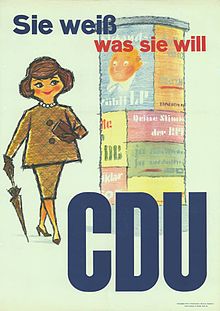State election in Lower Saxony in 1963
The state elections in Lower Saxony in 1963 took place on May 19, 1963. It was the election for the 5th Lower Saxony State Parliament . The coalition of the SPD, FDP and BHE under Georg Diederichs had to face the vote for the first time.
Result
Eligible voters: 4,701,245
Voters: 3,617,369 (turnout: 76.94%)
Valid votes: 3,582,244
| Political party | be right | Share in% |
Direct MAN date |
Seats |
|---|---|---|---|---|
| SPD | 1,608,927 | 44.91 | 69 | 73 |
| CDU | 1,351,449 | 37.73 | 25th | 62 |
| FDP | 316,552 | 8.84 | 1 | 14th |
| GDP | 132,446 | 3.70 | ||
| DP | 97.764 | 2.73 | ||
| DRP | 52,785 | 1.47 | ||
| DFU | 19,749 | 0.55 | ||
| DG | 2,190 | 0.06 | ||
| FSU | 243 | 0.01 | ||
| Individual applicants | 139 | 0.00 | ||
| Total | 3,582,244 | 95 | 149 |
Both popular parties were able to achieve strong profits. The SPD remained at 44.9 percent, however, a big lead of almost 7 percent of the vote before the CDU , which reached 37.7 percent. The FDP achieved a slight gain of 8.8 percent. DP and BHE merged in 1961 to form the All-German Party (GDP). After internal disputes in the GDP about the continuation of the Diederich I government with the SPD and FDP, a large part of the former DP MPs had converted to the CDU. Another part of former DP members reactivated the DP. The GDP, in fact identical to the previous BHE, failed with 3.7 percent at the five percent hurdle and no longer moved into the state parliament. The remaining DP with 2.7 percent also clearly failed to move back in. For the first time, only three parties were represented in the Lower Saxony state parliament.
The FDP tipped the scales as it was able to form a majority with both the CDU and the SPD. When the government was formed after the 1959 election, there had already been decisive differences between the FDP and the CDU, which had prevented a bourgeois government. In the school sector, the FDP raised concerns about the influence of exposed Catholics from the CDU. The FDP was the liberal school law received against the CDU call for a differentiation of the schools by religious denominations (so-called. Denominational school ). Finally, the FDP decided to continue the coalition with the SPD in the Diederich II cabinet . Political scientists Michael Koß and Tim Spier see Lower Saxony as a country that has often anticipated developments in Bonn in the history of the Federal Republic of parties. In 1963 one of the first social liberal governments was formed.
The coalition between the SPD and FDP broke up in 1965, however. The reason for the dispute was the concordat negotiations with the Catholic Church. The SPD had withheld from the FDP that an amendment to the school law would necessarily be linked to the Concordat, so that, among other things, the passage that stipulated the denominational school as an exception would have to be deleted. The liberal principles which the SPD had promised the FDP and which had only induced the FDP to join the coalition were thus up for grabs. After some back and forth, the FDP finally decided to reject the approach. She would not have closed her mind to a later school law change. She did not want to agree to the overall package with the Concordat. The coalition thus definitely failed in May 1965.
The SPD therefore turned to the CDU in order to form a new government and to be able to conclude the Concordat. In addition to the ministerial posts occupied by the FDP, the CDU demanded the Ministry of Agriculture from the SPD, so that Alfred Kubel (SPD) had to vacate this post and became finance minister. Georg Diederichs thus formed the only grand coalition in the German states at the time . This once again anticipated the development in Bonn. In 1966, Kurt Georg Kiesinger formed the first grand coalition at the federal level after the FDP had left its coalition with the CDU.
See also
literature
- Claus A. Fischer (Ed.): Election manual for the Federal Republic of Germany. Data on Bundestag, Landtag and European elections in the Federal Republic of Germany, in the federal states and in the districts 1946–1989, 2nd half volume , Paderborn 1990.
Web links
- Results at Wahlen-in-Deutschland.de
Individual evidence
- ↑ NIEDERSACHSEN: His best bottle . In: Der Spiegel . No. 22 , 1963 ( online ).
- ↑ LOWER SAXONY: On the high seas . In: Der Spiegel . No. 23 , 1963 ( online ).
- ↑ a b Koß, M./Spier, T .: Lower Saxony - The delayed adjustment to the federal German normality, in: Kost, Andreas / Rellecke, Werner / Weber, Reinhold (ed.), History of the parties in the German states, Munich : CH Beck, pp. 256-274.
- ↑ LOWER SAXONY: About the blade . In: Der Spiegel . No. 20 , 1965, p. 40 ( online ).
- ↑ LOWER SAXONY: Black and Red . In: Der Spiegel . No. 21 , 1965, p. 34 ( online ).
